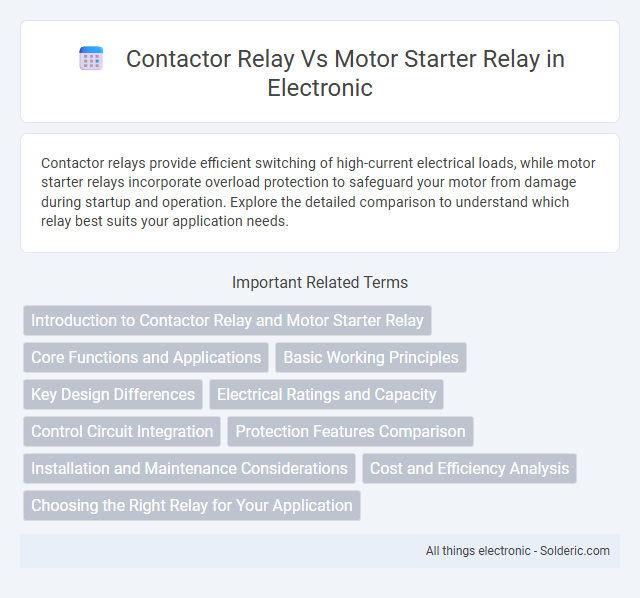Contactor relays provide efficient switching of high-current electrical loads, while motor starter relays incorporate overload protection to safeguard your motor from damage during startup and operation. Explore the detailed comparison to understand which relay best suits your application needs.
Comparison Table
| Feature | Contactor Relay | Motor Starter Relay |
|---|---|---|
| Primary Function | Switches electrical power circuits | Starts and protects electric motors |
| Application | General electrical load switching | Motor control with overload protection |
| Overload Protection | No | Yes, includes overload relay |
| Control Voltage Range | Wide, typically 24V to 480V AC/DC | Typically matched to motor specifications |
| Thermal Overload Relay | Not integrated | Integrated or attached externally |
| Typical Use | Lighting, heating, non-motor loads | Starting and stopping motors safely |
| Cost | Generally lower | Higher due to added protection features |
| Examples | Siemens 3RT, Allen-Bradley 700 | Siemens 3RW, Allen-Bradley Bulletin 193 |
Introduction to Contactor Relay and Motor Starter Relay
Contactor relays are electrically controlled switches used for switching an electrical power circuit, commonly employed to control lighting, heating, and electric motors. Motor starter relays combine contactors with overload protection devices to safely start and stop motors while preventing damage from electrical faults. Both devices are essential in industrial automation and motor control systems for efficient and reliable operation.
Core Functions and Applications
A contactor relay primarily serves to switch electrical power circuits on and off, making it ideal for controlling high-voltage loads such as motors, lighting, and heating equipment. Motor starter relays combine the contactor function with overload protection, enabling safe motor startup and shutdown while preventing damage from electrical faults. Applications of contactor relays include industrial automation and HVAC systems, whereas motor starter relays are essential in motor-driven machinery, conveyor belts, and pump control systems.
Basic Working Principles
Contactor relays operate by using an electromagnetic coil to open or close electrical contacts, enabling the control of high-power circuits remotely. Motor starter relays integrate overload protection with contactor functionality to not only start or stop the motor but also safeguard it from current surges and overheating. Both devices rely on electromagnetic principles but differ in application complexity, with motor starter relays providing enhanced motor protection alongside switching capabilities.
Key Design Differences
Contactor relays are primarily designed for switching electrical power circuits with high current loads, featuring robust contacts and a simple coil mechanism for efficient control. Motor starter relays incorporate additional protective components such as overload relays and thermal protection to safeguard motors from damage caused by phase failure or excessive current. The key design difference lies in the motor starter relay's integration of control and protection functions, unlike the contactor relay, which focuses solely on power switching.
Electrical Ratings and Capacity
Contactor relays typically handle higher electrical ratings, designed to switch currents ranging from 9A to over 150A at voltages up to 600V AC, making them suitable for heavy-duty industrial applications. Motor starter relays integrate overload protection and usually operate within a similar current range but emphasize capacity to safely manage motor starting currents and prevent motor damage due to overheating. The electrical capacity of motor starter relays ensures controlled power delivery and protection during motor startups, while contactor relays prioritize switching efficiency and durability under sustained high load conditions.
Control Circuit Integration
Contactor relays offer seamless control circuit integration through their simple on/off switching capabilities, ideal for applications requiring frequent motor start-stop operations. Motor starter relays combine contactors with overload protection elements, enhancing control circuits by safeguarding motors against overheating and electrical faults. Both devices support efficient control circuit design, but motor starter relays provide an integrated solution for motor protection and control.
Protection Features Comparison
A contactor relay primarily serves as a switch to control the power flow to motors but lacks built-in protection features, making it reliant on external devices for overload or short-circuit protection. In contrast, a motor starter relay integrates both the contactor and overload protection, safeguarding your motor from damage due to overheating or electrical faults. Choosing a motor starter relay ensures comprehensive motor protection, combining control and safety within a single unit.
Installation and Maintenance Considerations
Contactor relays require straightforward installation with simple wiring and minimal space, making them ideal for controlling electrical circuits with less maintenance needed over time. Motor starter relays involve more complex installation due to integrated overload protection and multiple components, requiring careful calibration and regular inspection to ensure optimal performance and safety. Your choice should weigh the ease of installation and ongoing maintenance efforts to suit the specific demands of your electrical system.
Cost and Efficiency Analysis
Contactor relays typically offer lower upfront costs but may lack certain protective features present in motor starter relays, which integrate overload protection to enhance motor safety and operational efficiency. Motor starter relays, while more expensive initially, can reduce maintenance expenses and downtime by preventing motor damage through thermal overload sensing. Your choice impacts long-term efficiency and cost-effectiveness, balancing initial investment against protection and reliability needs.
Choosing the Right Relay for Your Application
Choosing the right relay for your application depends on the specific requirements of your electrical system and load type. Contactor relays are ideal for switching high-current circuits and controlling electric motors with large starting currents, while motor starter relays provide integrated overload protection critical for motor safety. Your decision should weigh factors like load capacity, control voltage, and protective features to ensure optimal performance and reliability.
Contactor Relay vs Motor Starter Relay Infographic

 solderic.com
solderic.com